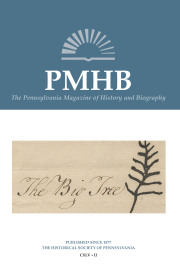Abstract
In the eighteenth and nineteenth centuries, watercourses were critical to processing and power for manufacturing, and Philadelphia County once had numerous creeks that mill proprietors exploited. A series of scaled surveys undertaken by Philadelphia County offcials when new roads or alterations to existing roads were proposed provides visual documentation of the importance of rivers and creeks to early industry. These records, part of the holdings of the Philadelphia City Archives, begin in the early years of the county. Much of the collection predates detailed, large-scale maps and thus is a unique record of the region’s development as well as a vital adjunct to textual material such as deeds and newspapers. Captured on a number of surveys are the dams, millponds, and raceways that became the power systems of early endeavors in textile and paper production, among other industries. The plans, drawn by district surveyors, also boast a certain degree of artistry; color washes and outlines or generic sketches of houses, stables, barns, inns, bridges, and the occasional church are common features. Striking on some of the plans as well are the topographical details that signal a county once flled with hills and valleys, its varied terrain making even small rills powerful when water descended. Surveyors mapped the land to facilitate the construction of county infrastructure, simultaneously documenting the landscape that such construction helped to obliterate.
